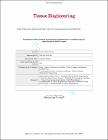| dc.contributor.author | KELLY, DANIEL | |
| dc.contributor.author | Prendergast, Patrick John | |
| dc.date.accessioned | 2009-04-14T17:29:22Z | |
| dc.date.available | 2009-04-14T17:29:22Z | |
| dc.date.issued | 2006 | |
| dc.date.submitted | 2006 | en |
| dc.identifier.citation | Kelly D.J. and Prendergast P.J. `Prediction of optimal mechanical properties for a scaffold used in osteochondral defect repair? in Tissue Engineering, 12, (9), 2006, pp 2509 - 2519 | en |
| dc.identifier.other | Y | en |
| dc.identifier.other | Y | |
| dc.identifier.uri | http://hdl.handle.net/2262/29149 | |
| dc.description | PUBLISHED | en |
| dc.description.abstract | The optimal mechanical properties of a scaffold to promote cartilage generation in
osteochondral defects in vivo are not known. During normal daily activities cartilage is
subjected to large cyclic loads that not only facilitate nutrient transport and waste
removal through the dense tissue but also act as a stimulus to the chondrocytes. In
contrast, cartilage tissue is commonly engineered in vitro in a static culture and hence, in
many cases, the properties of scaffolds have been tailored to suit this in vitro
environment. In this study, a mechano-regulation algorithm for tissue differentiation has
been used to determine the influence scaffold material properties on chondrogenesis in a
finite element model of an osteochondral defect. It is predicted that increasing the
stiffness of the scaffold increases the amount of cartilage formation and reduces the
amount of fibrous tissue formation in the defect, but this only holds true up to a certain
threshold stiffness above which the amount of cartilage formed is reduced. Reducing the
permeability of the scaffold was also predicted to be beneficial. Considering a nonhomogenous
scaffold, an optimal design was determined by parametrically varying the
mechanical properties of the scaffold through its depth. The Young?s modulus reduced
non-linearly from the superficial region through the depth of the scaffold, while the
permeability of the scaffold was lowest in the superficial region. As tissue engineering
moves from a science towards a product, engineering design becomes more relevant, and
predictive models such as that presented here can provide a scientific basis for design
choices. | en |
| dc.description.sponsorship | This work was funded by the European Union (EU) under the BITES project (Contract #:
QLK3-CT-1999-00559). | en |
| dc.format.extent | 2509 | en |
| dc.format.extent | 2519 | en |
| dc.format.extent | 4298110 bytes | |
| dc.format.mimetype | application/pdf | |
| dc.language.iso | en | en |
| dc.publisher | Mary Ann Liebert | en |
| dc.relation.ispartofseries | Tissue Engineering | en |
| dc.relation.ispartofseries | 12 | en |
| dc.relation.ispartofseries | 9 | en |
| dc.rights | Y | en |
| dc.subject | Mesenchymal Stem Cells | en |
| dc.subject | Fundamentals of Tissue Engineering | en |
| dc.title | Prediction of optimal mechanical properties for a scaffold used in osteochondral defect repair | en |
| dc.type | Journal Article | en |
| dc.contributor.sponsor | European Union (EU) | |
| dc.type.supercollection | scholarly_publications | en |
| dc.type.supercollection | refereed_publications | en |
| dc.identifier.peoplefinderurl | http://people.tcd.ie/pprender | |
| dc.identifier.rssinternalid | 34507 | |
| dc.identifier.rssuri | http://www.liebertonline.com/doi/pdf/10.1089/ten.2006.12.2509 | |




